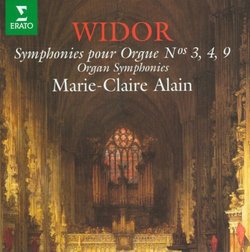| All Artists: Widor, Alain Title: Organ Symphonies 3 4 & 9 Members Wishing: 0 Total Copies: 0 Label: Elektra / Wea Release Date: 8/1/1995 Genre: Classical Style: Symphonies Number of Discs: 1 SwapaCD Credits: 1 UPC: 745099853426 |
Search - Widor, Alain :: Organ Symphonies 3 4 & 9
 | Widor, Alain Organ Symphonies 3 4 & 9 Genre: Classical
|
Larger Image |
CD DetailsSimilar CDs |
CD ReviewsDisappointing David A. Kemp | Plano, TX USA | 01/17/2004 (3 out of 5 stars) "I find this CD disappointing. To my ears the music is predominantly dull; the organ is tonally unattractive, unclear, and uninteresting; and the engineering is mediocre. I doubt that this CD is likely to win many new friends for Widor's organ symphonies. Charles-Marie Widor (1844-1937) was a celebrated and long-lived French organist (titulaire of the great Cavaille-Coll organ at Saint-Sulpice from 1870 to 1934), improviser, critic, composer, and professor of organ and composition. He was an important figure in French musical life and numbered among his pupils several who later distinguished themselves as organists and/or composers, including Tournemire, Vierne, Schweitzer, Dupre, Honegger, Milhaud. With Schweitzer he edited the complete organ works of Bach. The Norton/Grove Concise Encyclopedia of Music, ed. Stanley Sadie, says of Widor: "He is best known for his organ music, most of it secular and conceived to make full use of the elaborate resources of the grandiose contemporary instruments, notably those of Cavaille-Coll. He created the organ symphony [he wrote ten of them, 1876-1900], a decorative, powerful multi-movement piece that treats the organ as a kind of self-contained orchestra, using a wide variety of heavy technical demands." That is exactly what one wants, and hopes, to hear exemplified and demonstrated here, but alas, it doesn't happen. Widor wrote that "Cavaille-Coll's royal instrument" inspired him to compose his organ symphonies: "Had I not felt the allure of these timbres, the mystical spell cast by these waves of sound, I would not have composed organ music." That is why the choice of instrument is critical, but in this case the choice was badly made. The organ used here, billed as a Cavaille-Coll, has actually had four builders: Thierry (1698-1727), Cavaille-Coll (1852), Mutin (1903), and Haerpfer and Erman (1967). It was always a modest instrument and in its present unprepossessing incarnation has three manuals and 46 stops (no 32-foot pipes). At least as recorded here, it is characterized by tonal murkiness, lack of clarity and articulation, lack of interesting, colorful registrations, and lack of deep bass. A further disadvantage is a high level of residual wind noise, especially apparent and intrusive during soft or silent passages. There is all the difference in the world between this unimpressive organ and the huge (five manuals, 102 stops), powerful, colorful Cavaille-Coll masterpiece at Saint-Sulpice on which Widor played and composed. (For anyone wanting to hear the great Saint-Sulpice organ, I recommend Michael Murray's 1999 recording of Dupre, Franck, and Widor on Telarc CD-80516.) Surely Alain and Erato could have chosen a more suitable instrument than the one heard here. As for the Widor organ symphonies recorded here (No. 4 and No. 9, "Gothique," are complete, but No. 3 is represented only by excerpts), perhaps you have to be more of a Francophile than I am to respond to them (although I am certainly receptive to much other French music), but for me they are in the main academic, uninspired, and uninvolving, music that goes through the motions but doesn't seem to arrive at a significant destination--in short, unrewarding. (The listener may be reminded that when it comes to music for organ, there's Bach, and then there is everyone else.) Anyone who comes here seeking more of the kind of vigorous thrills provided by the famous Toccata of Widor's Fifth is going to be disappointed. The engineering (analog, 1977) is undistinguished, witness the aforementioned sonic murkiness and lack of deep bass, and a prevailing grainy texture of sound. The CD is generously filled at 71:46. Marie-Claire Alain has long been a splendid, versatile organist, one of the world's best, and I've enjoyed and admired a number of her CDs on Erato. Unfortunately this is not one of them."
|

 Track Listings (14) - Disc #1
Track Listings (14) - Disc #1
